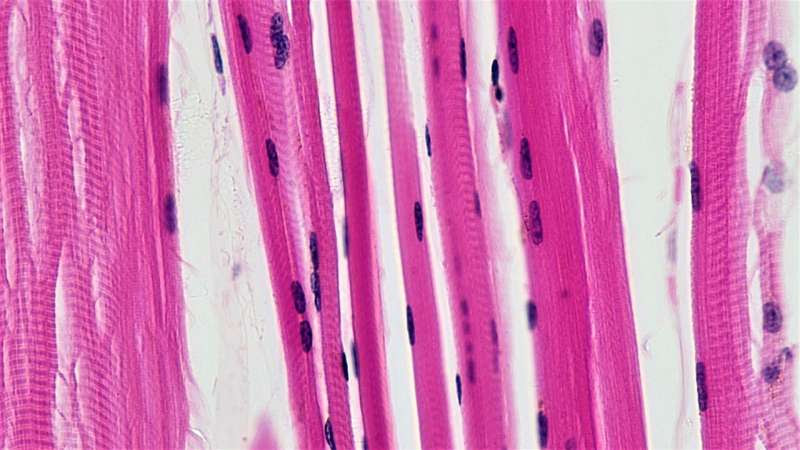by Ben-Gurion University of the Negev

Skeletal muscle fibers. Credit: Berkshire Community College Bioscience Image Library / Public domain
Statins are the most commonly used medication in lowering blood cholesterol, prescribed to tens of millions in the Western world. Statins act through inhibition of the enzyme HMG CoA reductase. Nearly 20% of statin users develop muscle symptoms (“statin myopathy”) including weakness and pain. In about 1%, this myopathy is severe and does not subside months after cessation of statin treatment.
A research team from Ben-Gurion University of the Negev and Soroka Medical Center discovered a severe hereditary muscle disease that develops around the age of 40 years, progressing by the early 50s to complete immobility of the limbs and the chest muscles, necessitating full-time artificial ventilation and eventually culminating in death. They went on to demonstrate that the disease is caused by a mutation in the gene encoding HMG CoA reductase, inhibiting the enzyme’s activity.
Attempting to cure the severe hereditary disease, the research group synthesized and purified Methylmevalonolactone, the normal product of HMG CoA reductase, which is lacking in those patients.
Following testing for safety in mice, the team got an exceptional “compassionate use” permit to give the novel medication, never given to humans before, to the most severely affected patient, who was near death—completely immobile and fully dependent on artificial ventilation. The patient has now been treated with the medication (orally, 3 times a week) for more than a year, with no side effects.Improvement in muscle function of HMGCR-LGMD patient with mevalonolactone treatment. After 4 months of treatment, patient V:2 is able to fully abduct her arm when laying, an action she was unable to perform for several years prior to treatment. Credit: Proceedings of the National Academy of Sciences (2023). DOI: 10.1073/pnas.2217831120
Not only did she stop deteriorating, she has improved dramatically: she can breathe without support for hours at a time, move her arms and legs extensively and even feed her grandchild. Other patients, some of whom are already in late stages of the disease, are awaiting treatment. The researchers estimate that there are dozens to hundreds of people affected by this hereditary disease—that could benefit from this effective life-saving treatment.
Based on the successful treatment of the hereditary disease, the research group went on to test whether the medication can be effective in the treatment of the non-remitting muscle problems occurring in ~1% of statin users. Indeed, they showed that the medication was extremely effective in a mouse model system mimicking the human statin myopathy. This is the first study to link muscle pain and weakness to statin use.
The entire research—from the human genetics and biochemistry studies to generation and purification of the medication, to the human and mouse trials—were done as part of the Ph.D. thesis of Dr. Yuval Yogev, guided by Prof. Ohad Birk, head of the Morris Kahn Laboratory of Human Genetics at Ben-Gurion University and director of the clinical genetics institute at Soroka Medical Center. Prof. Birk is also a member of the National Institute for Biotechnology in the Negev (NIBN).Improvement in muscle function of statin-myopathy murine model with mevalonolactone treatment. Mice treated with mevalonolactone (right) show much greater muscle endurance evaluated by wire-hanging test, as opposed to control mice (left). Credit: Proceedings of the National Academy of Sciences (2023). DOI: 10.1073/pnas.2217831120
The study was published last month in the Proceedings of the National Academy of Sciences.
Based on the findings, the research team are now seeking financial support / collaboration with the pharmaceutical industry to push forward standardized production and licensing of the medication, to save the lives of many individuals worldwide suffering from this hereditary disorder, as well as enabling treatment of tens of thousands of statin-myopathy patients. It should be noted that the FDA procedures are more lenient in licensing medications for rare diseases, thus rapid progress is expected in this regard.

Leave a Reply